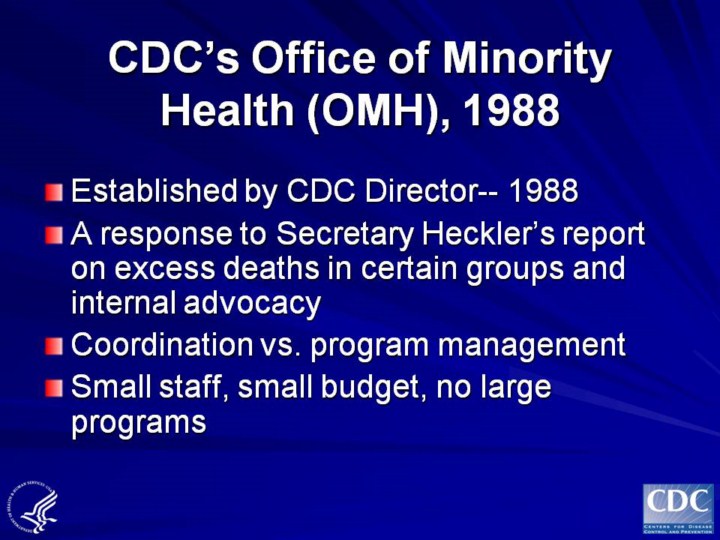| front |1 |2 |3 |4 |5 |6 |7 |8 |9 |10 |11 |12 |13 |14 |15 |16 |17 |18 |19 |20 |21 |22 |23 |24 |25 |26 |27 |28 |29 |30 |31 |32 |33 |34 |35 |36 |37 |38 |39 |40 |41 |42 |43 |44 |45 |46 |47 |48 |49 |50 |51 |52 |53 |54 |55 |56 |57 |58 |review |
 |
CDC’s Office of Minority Health (OMH), 1988
•Established
by CDC Director-- 1988
•A
response to Secretary Heckler’s report on excess deaths in certain
groups and internal advocacy
•Coordination
vs. program management
•Small
staff, small budget, no large programs
In January 1984, the Secretary of DHHS established the Task Force on Black and Minority Health in response to the national paradox of steady improvement in overall health, with substantial inequities in the health of U.S. minorities.
DHHS released its Report of the Secretary’s Task Force on Black and Minority Health on October 16, 1985. The report documented the disparity in key health indicators among certain groups of the U.S. population: blacks, Hispanics, Asian/Pacific Islanders, and Native Americans, compared to that of whites.
The DHHS “Office of Minority Health” was established following release of the report, to manage implementation of the report’s recommendations. CDC’s OMH was established in 1988, in response to the Heckler report and internal advocacy for a minority health office at CDC.
In general, the focus of this office was coordination rather than program management. The office had a small staff (~ 9), small budget (~ $ 1-2 million), and had no large program activities.
Note: 2-4 cooperative agreements established. $1-2 million budget. |